Since the diet of Ayurveda, is different form the modern point of consuming food, Ayurveda recommends a kitchen with different settings. For preparing Ayurvedic dishes, one must be equipped with certain utensils. These utensils are required to cook different dishes. These include a soup pot with lid made of stainless steel, one small metal pot for melting ghee, one heavy cast iron frying pan, one chapatti skillet, two to three medium sized pots with lids (best if made up of stainless steel), one deep pot for frying made of cast iron, one heavy frying pan with lid, hand egg beater, two to three mixing bowls, large metal spoon and soup ladle, blender, rolling pan and cutting board.
There are several spices, which are used in the kitchen to prepare an Ayurvedic diet. The spices used are as follows,
Asafetida (Hing) gives out an onion/ garlic flavour when heated. Asafetida is used for flavouring sauces, curries and pickles. Asafetida has antibiotic properties and is therefore used in medicines. It increases appetite and helps in digestion.
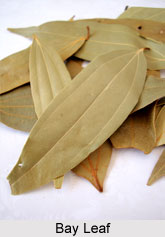 Bay Leaf (Tez patta) is a common spice used in almost every dish. The leaves possess aromatic, stimulant and narcotic properties. Bay leaf is applied over wounds and also helps in increasing the digestive fire.
Bay Leaf (Tez patta) is a common spice used in almost every dish. The leaves possess aromatic, stimulant and narcotic properties. Bay leaf is applied over wounds and also helps in increasing the digestive fire.
Bishop`s weed (ajwain) has a pungent flavor and is used to increase the taste of the dish. It is strongly recommended for medicinal purposes for intestinal colic, bronchitis, and bronchial asthma. It is also used as a stimulant for appetite, as a treatment for diarrhea and also in laryngitis as a gargle.
Cardamom large (badi elaichi) is generally used in preparing tea. Badi elaichi is used to cure infections in the upper respiratory tract and is also useful in nauseatic conditions. Cardamom small (Chotti elaichi) also has similar medicinal values.
Cassia, which in Hindi is called jangli dalchini, is used as a flavouring agent for baked items like candies, deserts and also in meat. Cassia is known for stimulating the digestive fire (agni) and is also used for treating cough.
Celery ( radhuni, ajmud and shalari) is used in beverages, seasoning meat, ice creams and baked goods and confectioneries. It is a used for treating asthma and liver diseases.
Chilli (mirchi) is added in small or large quantities in every kind of food. It generally adds flavour, colour and taste to the food.
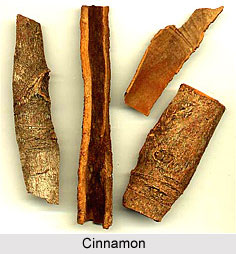 Cinnamon is called dal chini in Hindi, is used as a flavouring agent in various dishes. It is used as a stimulant, antiseptic, astringent and is used for treating nausea.
Cinnamon is called dal chini in Hindi, is used as a flavouring agent in various dishes. It is used as a stimulant, antiseptic, astringent and is used for treating nausea.
Coriander (dhaniya) is used in curries in order to enhance the flavour of the dish. Coriander is said to be an appetizer and is very good for the eyes. It provides vitamins and also acts as roughage to flush out the waste material.
Cumin, which is locally called jeera, is mostly used in all Indian dishes. It is an essential ingredient of garam masala. It helps in aiding digestion and also helps to cure stitches and pain. It also helps in removing Vata dosha from the body.
Curry leaf or curry pata as it is locally called, is used in dishes to give out a distinct fragrance. When it is fried in the oil it gives out a wonderful smell.
Dill is locally called sowa / suva and is used extensively in foods and beverages. These seeds are useful remedies during cold, flu and cough. They help provide relief during indigestion as well as constipation.
Fennel (saunf) is used as a flavouring agent in meat dishes, seafoods, pickles. Fennel is said to have medicinal value like it improves eyesight, aid digestion and also cut down obesity. They are also known as aniseed.
Fenugreek is known as methi in the local language. It is mainly used as a part of spices and curry powder. It is excellent for fish and baked goods seafood dishes, candy and soft drinks. It is used in lowering the blood sugar level and blood pressure. It is rich in vitamins, minerals and proteins. It is also used in controlling diabetes mellitus and also to control obesity. Various studies have shown that methi seeds control the lipid profile and also ideal for maintaining cholesterol levels in the body.
Garlic, which in Hindi is called lahson, is the king of all spices. Garlic has a lot of medicinal values. It helps in lowering cholesterol level and high blood pressure. It rises the immunity level, overcome fatigue and protecting cold and flu and many other benefits.
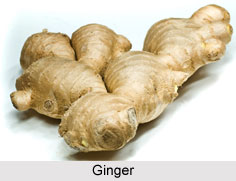 Ginger (adrak) is used in a number of Indian dishes. Ginger along with garlic is common ingredient in vegetarian and non-vegetarian dishes. It is used to treat stomach upset and also in treating diarrhea. It also helps indigestion, curing headaches, heart problems, nausea, arthritis, flu and common cold.
Ginger (adrak) is used in a number of Indian dishes. Ginger along with garlic is common ingredient in vegetarian and non-vegetarian dishes. It is used to treat stomach upset and also in treating diarrhea. It also helps indigestion, curing headaches, heart problems, nausea, arthritis, flu and common cold.
Hyssop, which in Hindi is called jufa, is used as a condiment in soups and salads. Hyssop is used for multiple purposes like it helps in curing gas in the alimentary tract and also an expectorant. It is also used in colds, coughs, congestion and relieving lung problems.
Kokam is also called kokam in Hindi, and is used as a garnish to give an acid flavour in curries, specially the Indian daal. It is very good for cooling syrups and the kokam butter is used as edible fat, which is nutritious. Kokam is used to elevate the appetite, and because it is acidic in nature it stimulates the digestive organs to produce enzymes.
Mace or jawitri, is a food flavoring agent and is used in tonics. It is suggested for treating inflammations of the bladder and urinary tract. It has an invigorating effect on the stomach and intestine and increases appetite. It reduces nausea, vomiting and diarrhea. It is used as a home remedy for many digestive problems. Externally, it is used in arthritis and chronic rheumatism.
Locally called pudina, mint has a distinctive flavour. It is used for flavouring meat, stews, tobacco, vinegar, fish, sauces, soups, and cordials. It is also used to garnish dishes. Mint has many medicinal values. It is used for curing rheumatism, headaches, cough and cold, stomach disorders. Oil prepared from mint leaves and dried mint leaves are used as antiseptic, stimulant, carminative and diuretic. It is used to cure respiratory infections as in tonsillitis, laryngitis and pharyngeal infections.
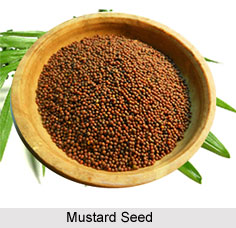 Mustard, which is locally called sarson, is used in the seed form as well as in the grinded form. Masard seed is used in pickles, salads, raitas while mustard powder is used in curries and sauces. It has a distinct hot flavour and is mostly used in all kinds of vegetarian dishes. Since it has a hot flavour it is used to calm down vata dosha. It increases appetite and also energizes the internal organs to secrete various enzymes. If the feet are dipped in a pot containing, mustard seed in put in hot water then it brings good sleep.
Mustard, which is locally called sarson, is used in the seed form as well as in the grinded form. Masard seed is used in pickles, salads, raitas while mustard powder is used in curries and sauces. It has a distinct hot flavour and is mostly used in all kinds of vegetarian dishes. Since it has a hot flavour it is used to calm down vata dosha. It increases appetite and also energizes the internal organs to secrete various enzymes. If the feet are dipped in a pot containing, mustard seed in put in hot water then it brings good sleep.
Nutmeg, which is jaiphal, is used as a condiment in sweet dishes. Nutmeg oleoresin is used in preparing baked foods, meat products, confectioneries, sauces, vegetables etc. The oil from nutmeg is used in cosmetics and toiletries. In Ayurveda, it is said, that it is used as a calming drug for brain. It helps in reducing mental stress and also useful in insomnia. When combined with certain other drugs, it is used for curing nausea.
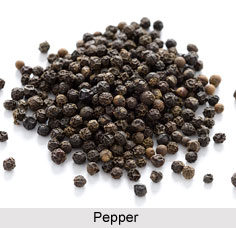 Pepper, which is locally called kali mirch, is an exotic Indian spice. It is used in pickles, and sprinkled over foods like French fries, pizzas; boiled eggs, egg omelet, chicken and other foods as well. This spice is one of the most important spices in Ayurveda, which has a medicinal value. It is also referred to as a wonder drug as it enhances health by means of rejuvenation. It is known for treating digestive problems. It also improves the quality of semen in men. Pepper is known to contain carminative, increasing the hemoglobin content of blood and anti-helmintic properties.
Pepper, which is locally called kali mirch, is an exotic Indian spice. It is used in pickles, and sprinkled over foods like French fries, pizzas; boiled eggs, egg omelet, chicken and other foods as well. This spice is one of the most important spices in Ayurveda, which has a medicinal value. It is also referred to as a wonder drug as it enhances health by means of rejuvenation. It is known for treating digestive problems. It also improves the quality of semen in men. Pepper is known to contain carminative, increasing the hemoglobin content of blood and anti-helmintic properties.
Pepper long, which is called pipli in Hindi, is sprinkled over fried stuffs and is used in pickles and chutneys. It is used to treat respiratory problems such as bronchitis, cough and asthma and other diseases like stomachache, diseases of spleen, tumors.
Pomegranate or anardana is used raw as well as dry. It is used as a spice in many dishes and used as garnishing in rice dishes, applesauce also on potatoes. It is used to decorate salads and vegetable curries because of its vibrant colour. It is a very useful spice as it is useful in chronic dysentery and diarrhea. Ayurveda suggests anardana is good for the heart owing to its sour taste (amla rasa). It provides relief from nausea, vomiting, cough and cold and also as a mouth freshner. The bark of the pomegranate tree serves as an anti -helmentic.
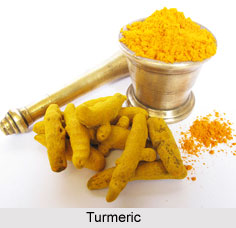 Tamarind or imli is a spice used for mainly preparing different chutneys, sauce. It can also be eaten raw and is also used in preparing sambhar. The pulp of tamarind is used in various culinary preparations. It is used to boost pitta dosha. As a medicine, it is used as an appetizer, laxative, healing and anti - helmintic. It is also used against fluorosis.
Tamarind or imli is a spice used for mainly preparing different chutneys, sauce. It can also be eaten raw and is also used in preparing sambhar. The pulp of tamarind is used in various culinary preparations. It is used to boost pitta dosha. As a medicine, it is used as an appetizer, laxative, healing and anti - helmintic. It is also used against fluorosis.
Turmeric is commonly known as haldi and is used in almost all Indian dishes. It can also be eaten raw. Turmeric is mainly used for healing wounds. It is one of the best remedies for diabetes and is also known for purifying blood. It is also known for lightening complexion and also fights any kind of fungal infection on the body. When taken with milk it is known for providing relief from sore throat or general respiratory problems like cough and cold.





